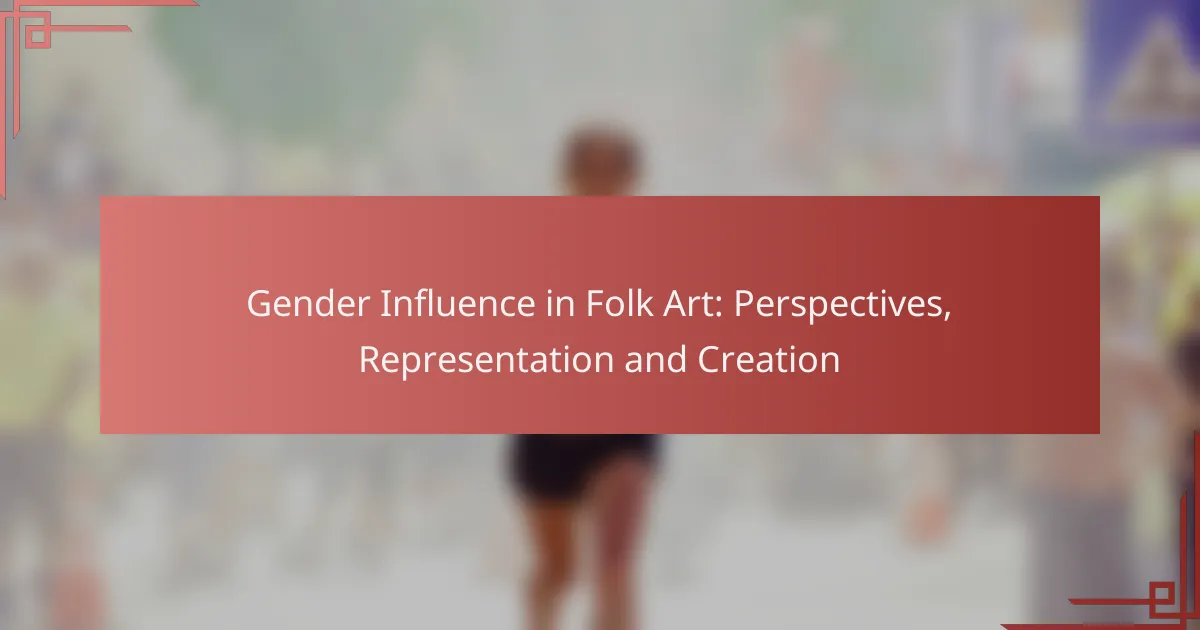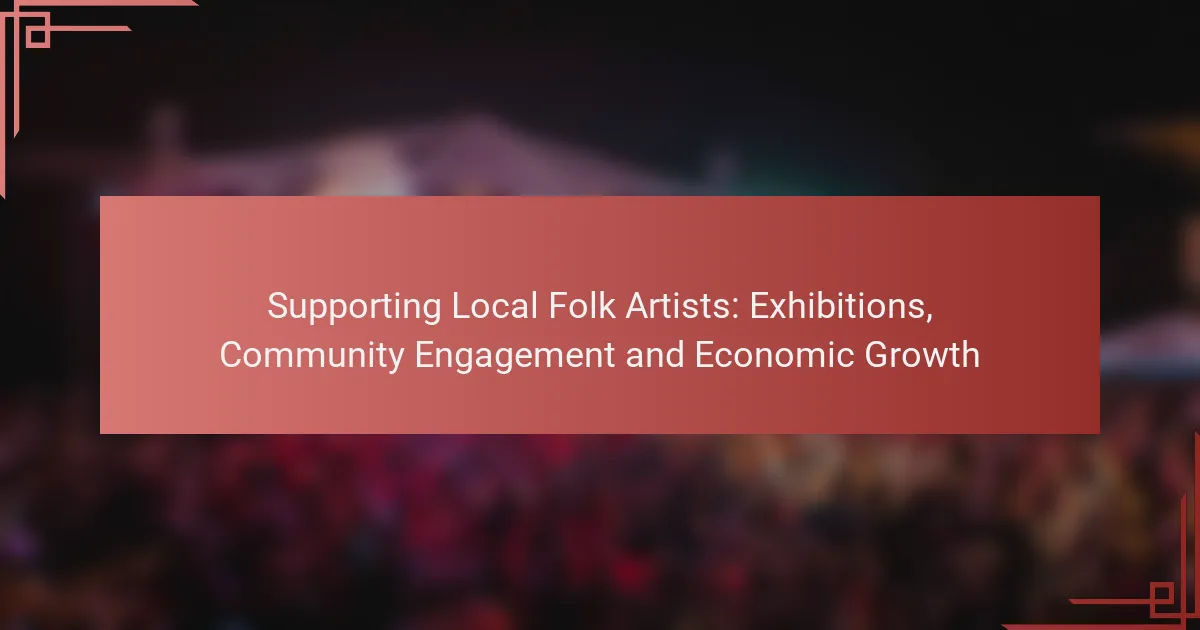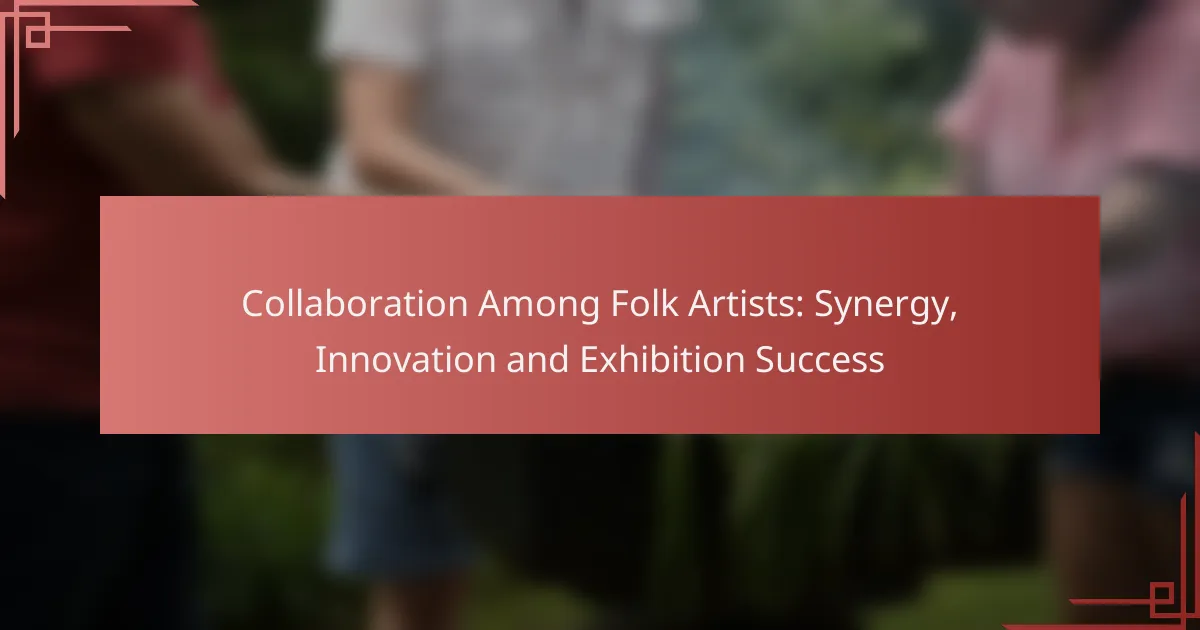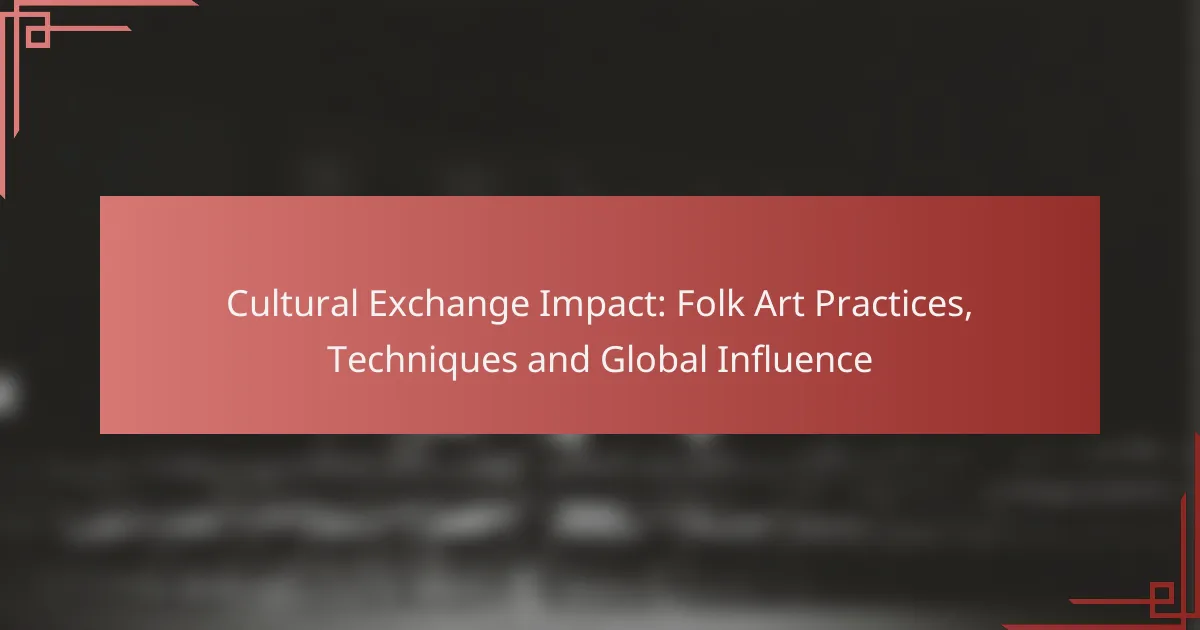Gender plays a crucial role in shaping folk art in the United States, influencing both the representation of artists and the themes they explore. The diverse perspectives brought by different genders enrich the narratives and aesthetics of this art form, revealing societal views on masculinity and femininity. Contemporary folk artists challenge traditional norms through their work, reflecting evolving identities and experiences related to gender while highlighting issues of empowerment and marginalization.

How does gender influence folk art in the United States?
Gender significantly influences folk art in the United States through the representation of artists and the themes they explore. Women and men often bring different perspectives and experiences to their creations, shaping the narratives and aesthetics of folk art.
Gender representation in traditional crafts
Traditional crafts in the United States often reflect gender roles, with certain crafts being predominantly associated with women, such as quilting and embroidery, while others, like woodworking and metalworking, are more commonly linked to men. This division can impact the visibility and recognition of female artisans in the folk art community.
Efforts to promote gender equality in crafts are increasing, with organizations and exhibitions highlighting the contributions of women. These initiatives aim to challenge stereotypes and encourage a more inclusive representation of gender in traditional crafts.
Impact of gender on artistic themes
Gender influences the themes explored in folk art, with women often addressing domestic life, community, and personal narratives, while men may focus on themes like nature, labor, and history. This thematic divergence can lead to a rich tapestry of storytelling within the folk art genre.
Artists may also use their work to comment on societal issues related to gender, such as identity, empowerment, and cultural heritage. This engagement with gender-related themes can resonate with audiences and provoke thoughtful discussions about the role of gender in society.
Case studies of female folk artists
Notable female folk artists, such as Faith Ringgold and Judith Scott, have made significant contributions to the genre by incorporating their experiences as women into their work. Ringgold’s quilts often tell stories of African American culture and women’s experiences, while Scott’s fiber art challenges perceptions of disability and identity.
These artists exemplify how female perspectives can enrich folk art, offering unique insights and fostering a deeper understanding of cultural narratives. By studying their work, one can appreciate the diverse expressions of gender in folk art and the importance of representation in this field.

What are the key perspectives on gender in folk art?
Key perspectives on gender in folk art explore how cultural expressions reflect and shape societal views on masculinity and femininity. These perspectives reveal the roles, contributions, and representations of different genders within folk traditions, highlighting both empowerment and marginalization.
Feminist interpretations of folk art
Feminist interpretations of folk art emphasize the significance of women’s voices and experiences in cultural narratives. This perspective often critiques traditional roles assigned to women, showcasing their creativity and agency in artistic expressions. For instance, women artisans may use folk art to challenge stereotypes and assert their identities.
In many cultures, feminist folk art can be seen in textiles, pottery, and storytelling, where themes of resilience and empowerment are prevalent. By analyzing these works, scholars and artists alike can uncover the underlying messages about gender equality and social justice.
Masculine narratives in folk traditions
Masculine narratives in folk traditions often reflect societal expectations of men, portraying them as providers, warriors, or leaders. These narratives can reinforce traditional gender roles but may also reveal vulnerabilities and complexities in male identities. For example, folk songs and tales frequently depict male figures grappling with honor and responsibility.
Understanding these masculine narratives is crucial for recognizing how they shape cultural attitudes towards masculinity. Artists and scholars can engage with these themes to promote discussions about modern masculinity and its evolution within contemporary society.

How is gender represented in contemporary folk art?
Gender representation in contemporary folk art often reflects the evolving roles and identities of individuals within society. Artists use their work to challenge traditional norms and express diverse experiences related to gender, showcasing both empowerment and critique.
Emerging female artists in urban settings
In urban environments, female artists are increasingly gaining visibility and recognition in the folk art scene. They often draw inspiration from their surroundings, incorporating elements of their cultural heritage while addressing contemporary issues such as gender equality and social justice.
These artists utilize various mediums, including textiles, murals, and installations, to convey their messages. For instance, community-based projects often involve collaboration with local residents, fostering a sense of solidarity and shared identity.
Gender fluidity in modern folk expressions
Modern folk art is increasingly embracing gender fluidity, allowing artists to express identities that transcend traditional binary classifications. This shift is evident in the use of non-conforming themes and symbols that challenge conventional gender roles.
Artists are exploring a range of materials and styles to reflect their experiences, often blending techniques from different cultures. This approach not only broadens the scope of folk art but also invites audiences to engage with diverse narratives, fostering inclusivity and understanding.
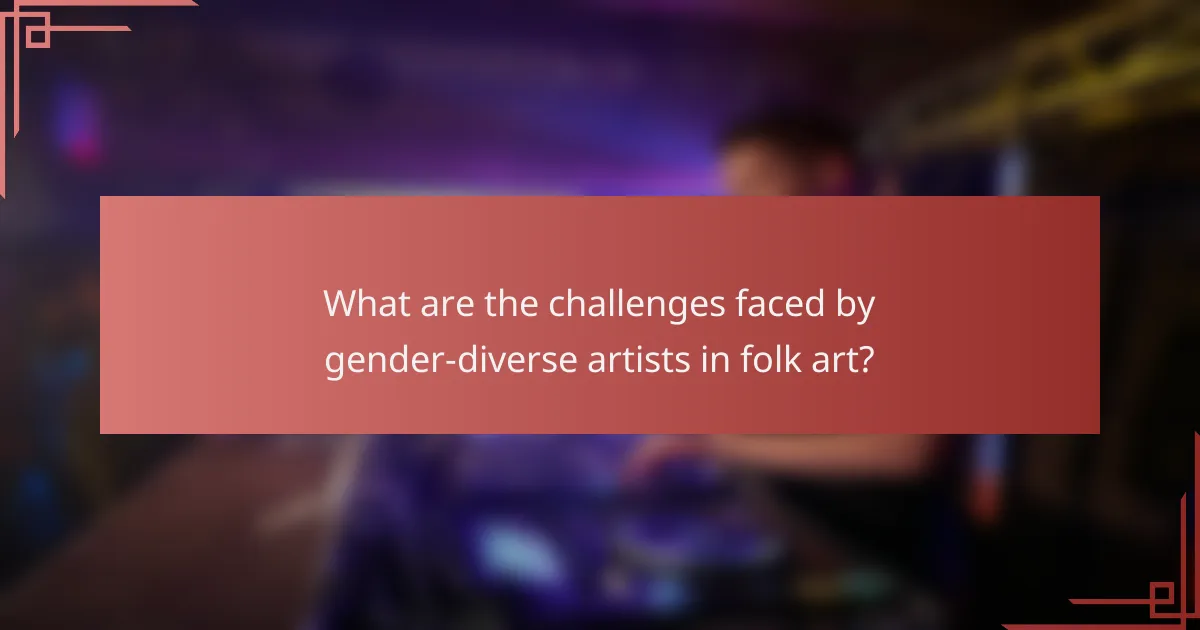
What are the challenges faced by gender-diverse artists in folk art?
Gender-diverse artists in folk art encounter numerous challenges that can hinder their creative expression and professional growth. These challenges often stem from societal biases, limited access to resources, and a lack of recognition within the art community.
Access to resources and funding
Access to resources and funding is a significant hurdle for gender-diverse artists. Many face barriers in securing grants, sponsorships, or even basic materials needed for their work. Traditional funding bodies may prioritize established artists, leaving emerging talent without the necessary support.
To improve access, artists can explore community-based funding initiatives or crowdfunding platforms that specifically support underrepresented groups. Networking within local art communities can also lead to collaborative opportunities that provide shared resources.
Recognition and visibility in the art community
Recognition and visibility are critical for the success of gender-diverse artists in folk art. Often, their work is overlooked in favor of more mainstream or traditionally recognized artists. This lack of visibility can perpetuate stereotypes and limit opportunities for exhibitions and sales.
To counteract this, artists should actively engage in social media and online platforms to showcase their work. Participating in local art fairs or exhibitions that celebrate diversity can also enhance visibility. Building relationships with art critics and curators who value inclusivity can further help elevate their profiles in the art community.
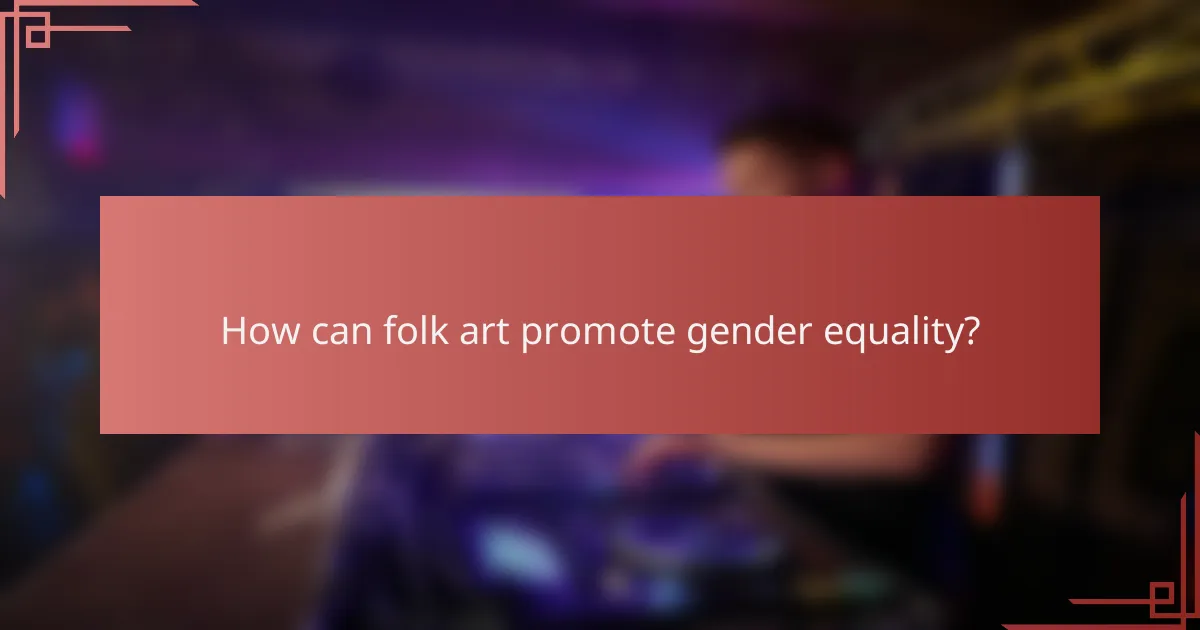
How can folk art promote gender equality?
Folk art can promote gender equality by providing a platform for underrepresented voices and fostering community engagement. Through creative expression, individuals can challenge stereotypes and highlight the contributions of all genders in cultural narratives.
Community workshops and inclusivity
Community workshops serve as vital spaces for inclusivity, allowing participants of all genders to collaborate and share their experiences. These workshops can focus on traditional crafts, storytelling, or performance art, encouraging diverse participation and representation.
To maximize inclusivity, organizers should consider factors such as accessibility, scheduling, and materials. Offering sessions in multiple languages or providing childcare can help ensure that everyone has the opportunity to engage fully.
Collaborative projects highlighting diverse voices
Collaborative projects can effectively showcase diverse voices in folk art, bringing together artists from different backgrounds to create shared works. These initiatives can include mural projects, textile collaborations, or community exhibitions that reflect the unique perspectives of various gender identities.
When planning these projects, it’s essential to establish clear communication and equitable roles among participants. This approach not only enriches the artistic output but also fosters mutual respect and understanding among collaborators, ultimately promoting gender equality within the artistic community.
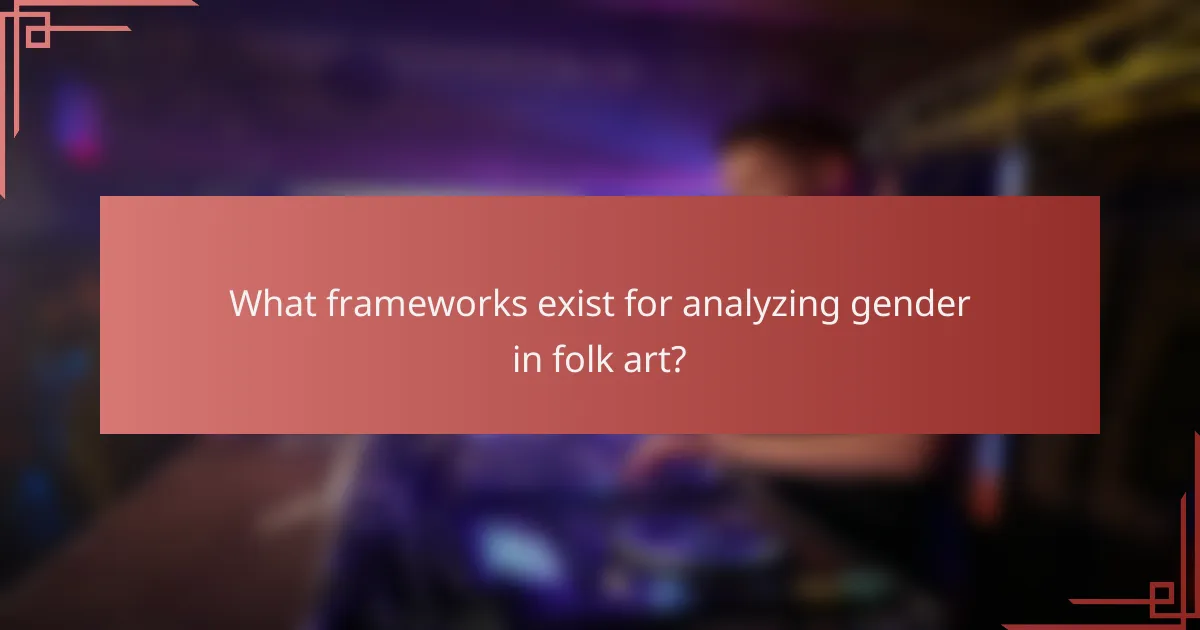
What frameworks exist for analyzing gender in folk art?
Analyzing gender in folk art involves various frameworks that consider the roles, representations, and influences of gender in artistic expression. These frameworks help to uncover how gender dynamics shape the creation and interpretation of folk art across cultures.
Intersectionality in art criticism
Intersectionality in art criticism examines how overlapping social identities, such as gender, race, and class, influence an artist’s work and the reception of that work. This approach recognizes that individuals experience multiple forms of discrimination or privilege, which can be reflected in their artistic expressions.
For instance, a female artist from a marginalized community may face different challenges and opportunities compared to her male counterparts. Critics should consider these factors to provide a more nuanced understanding of the artwork and its context.
Historical context of gender roles in folk traditions
The historical context of gender roles in folk traditions reveals how societal norms have shaped artistic practices over time. Traditionally, many cultures have assigned specific roles to men and women, influencing the types of art they create and the themes they explore.
For example, in some societies, women may have been responsible for domestic crafts, such as weaving or pottery, while men focused on more public forms of art like sculpture or painting. Understanding these historical roles can enhance the appreciation of folk art and highlight the contributions of different genders.

What are the future trends in gender and folk art?
Future trends in gender and folk art are increasingly shaped by digital innovation and globalization, which broaden the representation and visibility of diverse artists. As these influences grow, they create new opportunities for gender-diverse creators to express their identities and narratives through folk art.
Digital platforms for gender-diverse artists
Digital platforms are revolutionizing how gender-diverse artists share their work and connect with audiences. Websites and social media channels allow artists to showcase their creations globally, bypassing traditional gatekeepers in the art world.
For example, platforms like Instagram and Etsy enable artists to sell their work directly to consumers, fostering a more inclusive marketplace. Artists can leverage hashtags and online communities to reach specific audiences interested in gender-related themes in folk art.
Globalization’s impact on gender representation
Globalization is reshaping gender representation in folk art by facilitating cross-cultural exchanges and collaborations. As artists from different backgrounds interact, they can share diverse perspectives and challenge traditional gender norms within their art forms.
This interconnectedness can lead to a richer tapestry of folk art that reflects a variety of gender identities and experiences. However, it also raises concerns about cultural appropriation, where dominant cultures may exploit marginalized voices without proper acknowledgment or respect.
